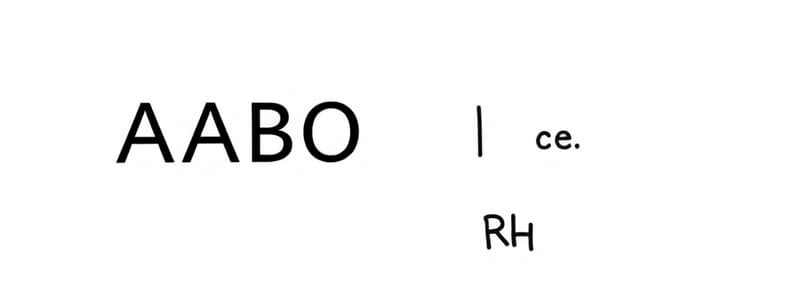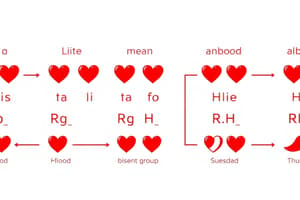Podcast
Questions and Answers
In ABO blood grouping, what does agglutination of red blood cells indicate when mixed with specific antisera?
In ABO blood grouping, what does agglutination of red blood cells indicate when mixed with specific antisera?
- The presence of corresponding antibodies in the blood sample.
- The absence of corresponding antigens.
- The presence of corresponding antigens on the red blood cells. (correct)
- A neutral reaction, indicating no specific blood group.
A patient's blood sample agglutinates with both Anti-A and Anti-D sera. What is the patient's blood group?
A patient's blood sample agglutinates with both Anti-A and Anti-D sera. What is the patient's blood group?
- B positive
- A positive (correct)
- A negative
- B negative
Why is it important to determine the Rh factor in addition to the ABO blood group before a blood transfusion?
Why is it important to determine the Rh factor in addition to the ABO blood group before a blood transfusion?
- ABO blood groups are not as important as the Rh factor.
- Rh factor determines the color of the blood.
- Rh incompatibility can lead to transfusion reactions. (correct)
- Only the ABO blood group needs to be matched for compatibility.
In the blood grouping procedure, if a drop of blood doesn't agglutinate with Anti-A, Anti-B, or Anti-D sera, how would you interpret this result?
In the blood grouping procedure, if a drop of blood doesn't agglutinate with Anti-A, Anti-B, or Anti-D sera, how would you interpret this result?
How do the terms 'agglutinogens' and 'agglutinins' relate to blood group determination?
How do the terms 'agglutinogens' and 'agglutinins' relate to blood group determination?
A medical researcher is investigating the genetic inheritance of blood types. Why is blood grouping information valuable in this type of study?
A medical researcher is investigating the genetic inheritance of blood types. Why is blood grouping information valuable in this type of study?
In a scenario where a blood transfusion is necessary, why is it MOST critical to accurately determine both the ABO and Rh blood groups of the donor and recipient?
In a scenario where a blood transfusion is necessary, why is it MOST critical to accurately determine both the ABO and Rh blood groups of the donor and recipient?
During a blood grouping practical, a student observes agglutination in the Anti-A well and no agglutination in the Anti-B and Anti-D wells. What might explain this unexpected result?
During a blood grouping practical, a student observes agglutination in the Anti-A well and no agglutination in the Anti-B and Anti-D wells. What might explain this unexpected result?
Flashcards
ABO Blood Grouping
ABO Blood Grouping
System to classify blood based on antigens on red blood cells.
Rh Blood Grouping
Rh Blood Grouping
Determines if Rh antigen (D) is present on red blood cells.
Agglutinogens
Agglutinogens
Substances on red blood cells that trigger antibody production.
Agglutination
Agglutination
Signup and view all the flashcards
Anti-sera
Anti-sera
Signup and view all the flashcards
Rh Positive (Rh+)
Rh Positive (Rh+)
Signup and view all the flashcards
Rh Negative (Rh-)
Rh Negative (Rh-)
Signup and view all the flashcards
Blood Transfusion Importance
Blood Transfusion Importance
Signup and view all the flashcards
Study Notes
- Practical class completion enables students to understand the importance of studying ABO and Rh blood groups, how to determine blood group, and the clinical significance of blood grouping.
ABO and RH Blood Grouping Principle
- Red blood cells have different types of agglutinogens on their surface.
- Red cells reacting with known agglutinins in sera determines the blood group of a subject.
- RBC agglutination indicates the presence of antigens specific to the antibodies.
Rh Blood Group
- The Rh factor was first discovered in the Rhesus monkey.
- The Rh factor exists in 85% of humans.
- The most common Rh antigen is D
- Rh +ve persons have the Rh antigen on the red cells.
- Rh -ve persons do not have Rh antigens on the red cells
Requirements
- Necessary reagents include Anti A sera, Anti B sera, and Anti D sera.
- Glass slides, a dropper, gauze swab, and 3 applicators.
- Blood sample and gloves.
Procedure
- The slide is placed on white paper.
- Drops of Anti A, Anti B, and anti D are placed on the slide respectively.
- Placement of each drop should be noted on the paper.
- A drop of blood sample is added to each slide.
- The serum and blood on each slide are mixed with an applicator.
- Wait 5-10 minutes, then examine the slide for agglutination.
Interpretation
- Anti-serum with A antigen reacts with Anti A antibody.
- Anti-serum with B antigen reacts with Anti B antibody.
- Blood Group A has A antigen and Anti-B antibody.
- Blood Group B has B antigen and Anti-A antibody.
- Blood Group AB has AB antigen and no antibodies.
- Blood Group O has no antigens and Anti-A and Anti-B antibodies.
- The presence of agglutination in Anti-D antibody indicates an Rh+ blood type when testing for Rh antibodies.
Agglutination Reactions of Blood Groups
- Type AB contains agglutinogens A and B and agglutinates with both sera.
- Type A contains agglutinogen A and agglutinates with anti-A.
- Type B contains agglutinogen B and agglutinates with anti-B.
- Type 0 contains no agglutinogens and does not agglutinate with either serum.
Significance of Blood Grouping
- Blood grouping is pivotal in blood transfusion for treatment, Rh incompatibility determination, genetic studies and medicolegal uses.
Studying That Suits You
Use AI to generate personalized quizzes and flashcards to suit your learning preferences.
Related Documents
Description
Learn about ABO and Rh blood groups: their principles, and clinical significance. Understand how to determine blood groups using Anti A, Anti B, and Anti D sera. Includes procedure and the reagents required for the practical class.



